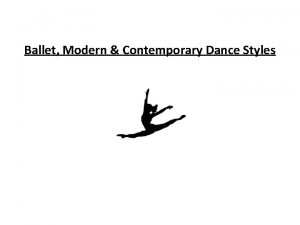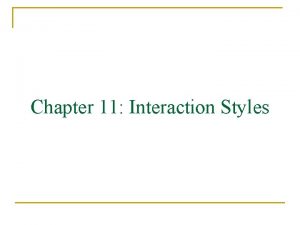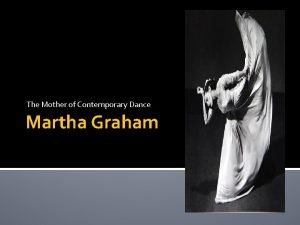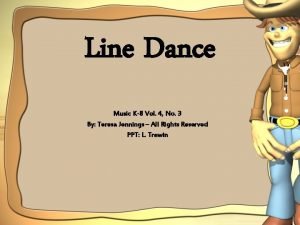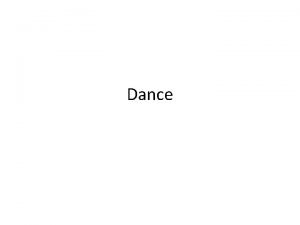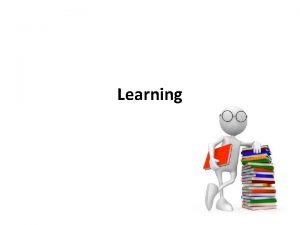Characteristics of Contemporary Dance Different styles of dance












- Slides: 12

Characteristics of Contemporary Dance • Different styles of dance have a particular way to produce or perform movement. • However it is very hard to define Contemporary Dance. • Contemporary itself is a Genre not a technique because it incorporates a range of different styles to create its own unique look.

Contemporary Genre • First we need to think about the other similar styles out there: • Classical ballet involves adherence to technique and style • folk/national dance involves using traditional music and steps • tap/theater dance/jazz use popular music and happy themes. If it’s none of the above, the dance is contemporary.

Contemporary Genre • Contemporary dance tends to be intricate and physical, and the dancers change levels and directions quickly and seamlessly. • Contemporary dance may deal with abstract concepts, images, or emotional extremes. • Some contemporary choreography tells a story based on the words of a song, but other pieces have story lines known only to the dancers and their choreographer.

Some History. . . • Contemporary emerged in the 1950’s out of the constraints of Classical Ballet. • A lady called Martha Graham decided to rebel against the rigid style of Ballet and perform movement that was ‘freer’ and involved using the body and gravity. • She started to use costumes that were away from the traditional lyrical dresses and Ballet Tutus. • From here Contemporary Dance continued to develop into ‘Modern Dance’ as it is today.

Contemporary Dance • There are 5 main techniques used in Contemporary Dance: 1. Cunningham 2. Graham 3. Limon 4. Release 5. Improvisation

Cunningham (named after teacher and choreographer Merce Cunningham) This style focused on the architecture of the body in space, rhythm and articulation. What does that mean? Cunningham uses the idea of the body's own "line of energy" to promote easy, natural movement.

Graham (named after Martha Graham) This style focuses on the use of contraction, release, fall and recovery. What does that mean? Graham technique is characterised by floorwork and the use of abdominal and pelvic contractions. The style is very grounded and the technique visibly contrary to the sylphlike, airborne ideals of ballet.

Limon (named after Jose Limon) Involves exploring the use of energy in relation to gravity and working with weight in terms of fall, rebound, recovery and suspension. What does that mean? Limon technique uses the feeling of weight and "heavy energy" in the body, and movement is instigated using breath to lift, and swings through the body to create and halt movement. It also feels very nice to perform!

Release Placing emphasis on minimising tension in the search for clarity and fluidity and efficient use of energy and breath. What does that mean? A bit like it sounds - in Release technique, we release through the joints and muscles to create ease of movement, releasing the breath to aid the release of the body. A great relaxation technique as well as a dance style.

Improvisation • Improvisation focuses on the investigation of movement and its relation to performance. Development of individual movement material is facilitated through a variety of creative explorations. • Contact Improvisation Contact improvisation describes a duet dance form characterised by weight exchange, fluid movement and touch. Partners improvise using the natural movement of the body.

The Performers • Different characteristics of the performers will also have an impact on the dance performance. • Sometimes these characteristics are selected for a reason like race, sometimes it is who is available or the best options to perform the dance.

The Performers Characteristics
 Contemporary ballet characteristics
Contemporary ballet characteristics Characteristics of contemporary dance
Characteristics of contemporary dance We're gonna dance to one song
We're gonna dance to one song Contemporary leadership styles
Contemporary leadership styles Advantage and disadvantage of buffet service
Advantage and disadvantage of buffet service Different styles of greenhouses
Different styles of greenhouses Different interaction styles
Different interaction styles Influencing techniques
Influencing techniques Martha graham technique spiral
Martha graham technique spiral David nurenberg
David nurenberg Characteristics of contemporary literature
Characteristics of contemporary literature The mississippi cha cha slide
The mississippi cha cha slide Everybody dance and sing line dance
Everybody dance and sing line dance

